Tech Talk: The Future of Oil Shale
Posted by Heading Out on April 11, 2010 - 11:00am
I have spent some time over the past few weeks writing about various different ways of producing oil from oil shale. While it is now about time that I move on to other topics, David Hagen was kind enough to post the website that gives access to the presentations from the Oil Shale Symposia that I mentioned at the beginning of this mini-series.
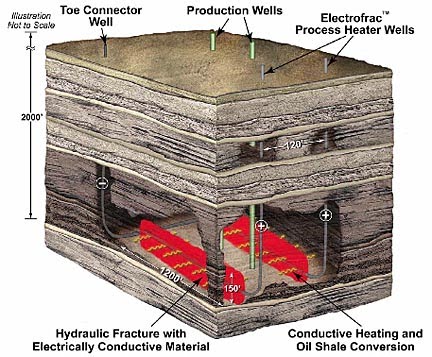
The papers from the 28th Symposium in 2008 illustrate that while the current price of oil may not currently justify the development of large oil shale operations, it can justify the investment of research dollars to seek better ways of producing oil from these fields. This is particularly true if one accepts one of the criteria that Exxon used to justify their ongoing interest, namely that they project that world energy demand will be 40% higher in 2030 than today, with more than 80% of that energy still being supplied by fossil fuels. Exxon believes that the oil from oil shale will play a significant role in that supply.
And so I am going to skip lightly through the papers, and highlight anything that catches my eye.
Exxon Mobil, for example, are looking into Electrofracking the shale. The idea of using electrical power directly to break rock has been around for some time. Erich Sarapuu wrote his doctoral dissertation on this in the 60s as I recall, unfortunately before the internet made it easy to find much information, though he went on to form Electrofrac Corp. And there have been more recent papers. However it appears that by putting electrically conductive materials into the fractures and passing current through them, Exxon Mobil both limits the surface footprint, and the amount of material that has to be heated to achieve the transformation of the kerogen. Higher rock stress can apparently also lighten the oil produced, based on lab tests. Since the time of the Symposium, Exxon Mobil has run a successful field test at their Colony Mine site, but has been quoted as commenting:
ExxonMobil sees tantalizing prospects for shale: up to 162,000 barrels of oil per surface acre at a 50 percent recovery rate. The results suggest a 3-to-1 ratio of energy recovered over energy expended to obtain it, McGinn said...It appears ExxonMobil can make its process work using about 1.5 barrels of water for each barrel of oil produced, he said.
Even under the most optimistic of scenarios, ExxonMobil sees no production coming from oil shale for 10 to 24 years, McGinn said.

Shell have also reported that the ground conditions can change the quality of the oil produced, and that slower heating increases oil quality, while higher pressures increase the hydrogen content of the oil. Field tests confirmed the lab information. (And for those who wondered about the ability to make jet fuel from oil shale, they also added this table):
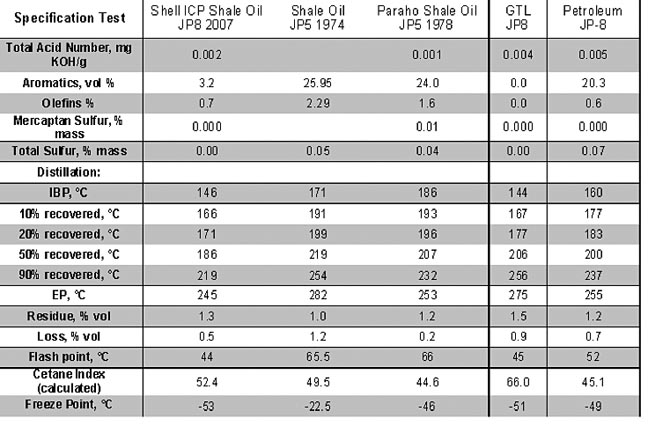
In contrast Chevron has looked at sending hot gases that are surface generated down and through induced fractures:
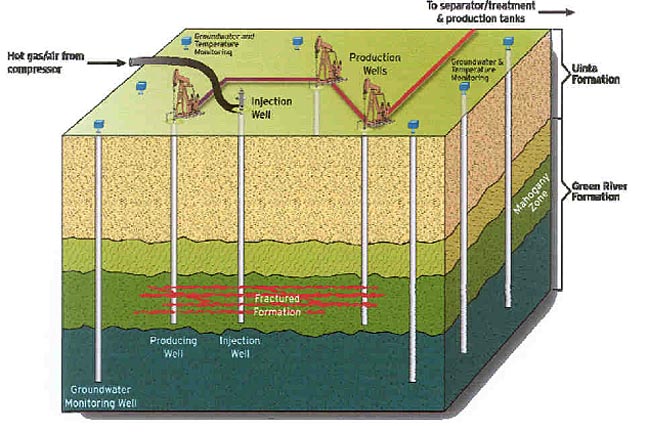
The U.S. Bureau of Mines did look at fragmenting the oil shale beds in place and then igniting them for an in-situ variation on the Ecoshale process I described last time (in the sense that the shale is heated within a geological retort).
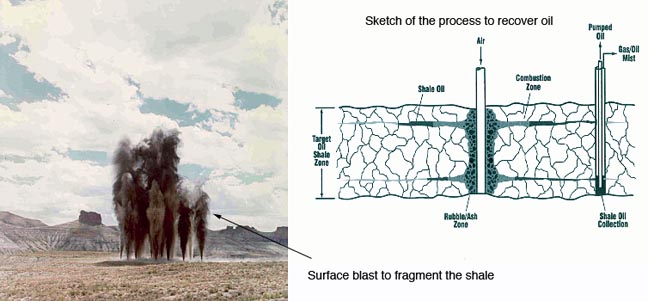
And I have previously written about the paper on the ground freezing test that Shell has carried out:
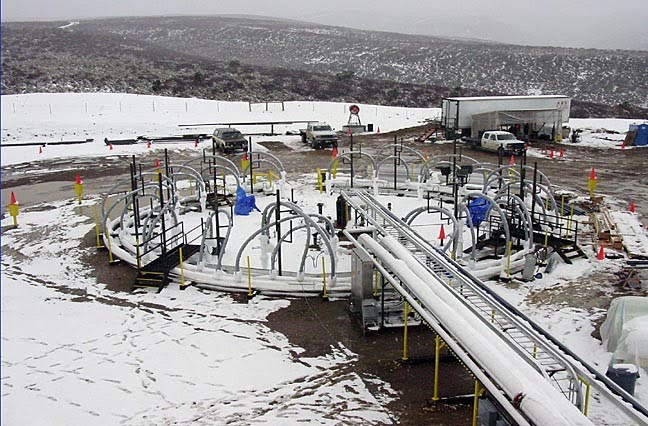
There is work being done by Total (who slipped in a comment that oil supply may peak before 2015). They see the world potential supply from oil shale as being measured in trillions of barrels of oil. They are collaborating with Petrobras in surface retorting programs and along with other companies encouraged by the Jordanian government evaluating deposits in Jordan, which is also examining microwave heating and Morocco. They are collaborating with Independent Energy Partner on geothermal fuel cells for in-situ heating and looking at downhole radio-frequency heating. There has been a subsequent paper on the Moroccan oil shale development.
The use of radio frequency heating was described, with the Bechtel/Parsons conclusion that the process could yield an EROI of greater than 3. And the potential for using wind energy to power the microwaves was advanced.
The program being developed by EGL where the heating is supplied around the outside of a series of wells was also included.
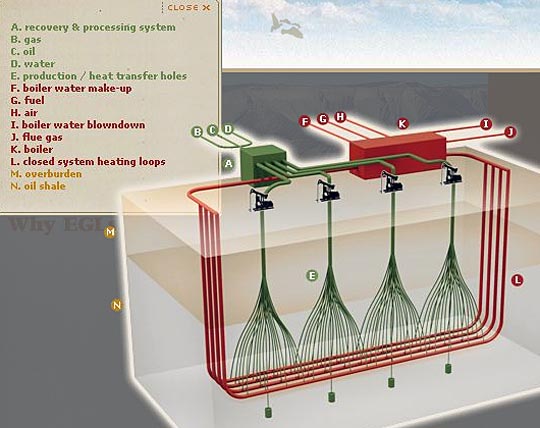
There is a report available on unconventional fuels that looks at oil shale, transmitted in December 2008. There was also, from August of that year, a complimentary list of companies carrying out research into oil shale and tar sands.
The Power Engineering Institute in Moscow discussed some of the work being done in Russia on both their deposits and those in other parts of the world. The Narva thermal refinery in Estonia has, for example, increased production to over a million barrels exporting about 40% of the product. The plant uses ash as a pre-heating step, and used automobile tires as part of the feed stock. A better list of some of the oil shale projects can be found at the Oil Shale Association.
One thing is clear from perusing both the Proceedings and the additional papers that I have chased up to try and update some of the information. The Oil Shale resource around the world will become an increasingly viable one as the price and availability of conventional oil become more of a strain on the world and individual nations. This is being recognized by countries such as Jordan, China and, Thailand. Plans range from continued examinations of more exotic methods for oil recovery, to the more conventional mining and surface retorting. The level of activity appears to be rising again, and thus while the continuous posting on the topic will now halt, I will come back to the subject intermittently in the future. It is a comment on the perceived future scarcity of conventional oil, that this subject is receiving so much attention.




Thank you for taking the time and effort. I do hope that the hydrocarbons won from such absurd extraction techniques does not get burned up as fuel, but ends up as some other useful endproduct, and that the end products reflect the true costs/energy involved.
The take away for me is that we will try anything. Definitely time to move on. I think I have a number of herbs that need repotted. I am (re)using plastic pots.... for now.
ta ta for now.
just one more thing. By injecting "conductive material" (and other junk) into the formation you are changing that formation - Eventually it will be exposed through erosion or further buried and metamorphosed. This is another type of human bioturbation of a rock formation, a human-concentration of ore if you will. another record of human activity on this planet preserved in the fossil record. ~:)
Thanks for the post.
None of these engineering plans appears to be cheap! I'm guessing that a price somewhat above $85 will be needed to make any of these financial viable.
BAU from shale???
So how exactly has tiny Estonia been able to subsidize shale oil production if it has not been financially viable?
Majorian, oil shale production and oil from shale are two entirely different things. Estonia mines oil shale and burns it in their power plant boilers, just like coal. They, of course, have a very serious shale ash problem.
Econbrowser: Oil Shale Retort
That report is not quite correct. Estonia still produces some oil from shale but of course Estonia's shale is very rich in oil, or kerogen, producing about 147 kilos of oil per ton or 14.7 percent. That is a much higher percentage than most oil shales.
Wikipedia, Oil Shale
Ron P.
Yes, the Estonians have been using oil shale far more to make electricity but according to their records since the 1960s they have consistantly produced 345000 tons of shale oil per year of which they export 222000 tons .
http://www.kirj.ee/public/oilshale/Est-OS.htm
http://en.wikipedia.org/wiki/Oil_shale_in_Estonia
http://en.wikipedia.org/wiki/Narva_Oil_Plant
Is it remotely plausible that tiny Estonia is subsidizing shale oil exports which TODers claim is not economic??!
345,000 tons per year comes out to about 6.9 thousand barrels per day, hardly enough to make a dent in world oil production.
Apparently you misunderstand the meaning of "subsidizing". The only reason Estonia would need to subsidize the oil shale industry would be because it is not economical. In other words the industry needs to be subsidized by the government to be viable.
A subsidy is the opposite of a tax. The government gives the industry money in order to keep the business going and to keep people employed. And if it is an export business it helps their trade balance. But if it ever became economical, you can bet the government would stop subsidizing it. And if it became very economical they would begin to tax it.
Our government is subsidizing many farmers in order to keep them from going baknrupt.
Corn Ethanol Subsidies
Without that subsidity the corn ethanol industry would not be economical.
Ron P.
Estonian exports of petroleum peaked in 1999 at 14.15 kb/d and have subsequently dribbled down to nothing. Their whole nation had less significance globally than the Tupi EWT. Their shale industry has given rise to a whole host of environmental horrors too.
Obviously that depends on the price of gasoline which depends on the price of oil and the wholesale gasoline margin of ~43 cents.
If the price of oil is $80 per barrel then the wholesale price of gasoline would be about $2.33, plus 18.4 cents federal highway gas tax and 20-40 cents of state taxes = ~$2.8 per gallon.
E100 gets a 51 cent per gallon tax credit, so the blend E10 gets a 5.1 cent reduction in the federal gas tax.
The refineries took in 520,000 barrels of ethanol per day or 7.9 billion gallons per year.
The US produced ~88 billion gallons of E10 in 2009 so the amount of money sent to blenders was about $4.5 billion dollars cost. Given a wholesale gasoline price of $2.33 and $1.66 per gallon for ethanol, the price of E10 works out to be $2.27 per gallon or 6 cents less than straight gasoline or $5.28 billion dollars saved by consumers. Adjusting for the fact that E10 has 98% of the energy of straight gas, that's $5.17 billion dollars saved.
The difference between credit paid out and savings with the 98% efficient E10
is $0.67 billion dollars.
The break evenpoint would be an oil price of $57.5 per barrel;
(1- 90%x .98) x (Oilprice/42 +$.43)-$1.66 x 10% x .98 =$.051 or $57.48
As the oil price rises, the subsidies help keep pump prices down, which is what happened in the recent past.
Err, you are changing the subject again. I just mentioned ethanol to give you an example of what a subsidy was. But the subject was, and is, shale oil. You seemed to think that the fact that Estonia was subsidizing shale oil production meant it was economical. Actually it means exactly the opposite.
Oh, the ethanol subsidy is not there to keep pump prices down. It is there to give the farmer and the ethanol producer a break. Without the subsidy they both would be out of business. It is all part of the grand “renewables” scheme. It is supposed to be the first step in curing our dependence on foreign oil.
Ron P.
From what reference do you conclude that "Estonia IS subsidizing oil from shale"? To me it appears that Majorian is questioning whether or not Estonia is subsidizing oil from shale production, then exporting that product, which would make little apparent sense, thus LIKELY proving that their production is presently economical at current market prices.
Lengould, read Majorian's statement again. It is produced here again, with the word "subsidize" in italics, exactly as he originally put it.
He is clearly stating that subsidizing shale oil is something that Estonia is doing and questioning how this is possible if shale oil is uneconomical. I do not know that Estonia is subsidizing shale oil, I just took his word for it. He, Majorian, was the one who first stated such so I just presumed he had the evidence.
Ron P.
No, Ron.
Lengould has interpreted what I 'meant' to say exactly while you torture my wording.
Clearly, clearly that statement assumes that Estonia does subsidize shale oil production.
Lengould gave you an out and you are jumping at it. Well really I don't blame you. You are always working yourself into a corner and it is only natural that you look for a way out. However your words can only be interpreted one way. And, I must add, you only thought of that out when Lengould gave it to you. You had every opportunity to bring it up yesterday but neglected to do so.
Ron P.
I think you explained the basics of subsidies quite clearly in your first reply. I will add that political clout can keep subsidies in place to sweeten the pot at taxpayer's expense even if subsidies are no longer necessary to make something economically viable.
I agreed (see below) it seems only marginally plausible that a direct subsidy is given to the oil-shale works in Estonia.
However:
(1) the country has recently transitioned to a market economy, so the capital costs of the oil shale electric power (Narva commissioned 1965) and oil plants was likely subsidized under the socialist regime.
And the plant owner is a still state owned company per: http://en.wikipedia.org/wiki/Eesti_Energia
(2) the Narva electrical power plants also product heat for district heating, thus another source of income.
(3) the oil shale in Estonia is some of the richest around -> less cost to mine a given amount of energy. from http://en.wikipedia.org/wiki/Oil_shale_in_Estonia
"Estonian kukersite deposits are one of the world's highest-grade deposits with more than 40% organic content and 66% conversion ratio into shale oil and oil shale gas."
(4) Estonia doesn't have any oil, natural gas, or coal. Thus it's competition must pay import freight...
Opps! Just found this:
http://www.kirj.ee/public/oilshale/ed-page5.html
It mentions (at least historical) subsidies.
So I guess one must conclude that the were and are to some degree subsidies on Estonian oil shale, and some fortunate externalities (high quality shale, no local competition) that likely don't apply to other oil shales.
A bit of dated background info.
http://www.geni.org/globalenergy/library/national_energy_grid/estonia/En...
The subsidy in your link is that the Estonian electrical grid 90% being powered by oil shale, mines an 'excess' of oil shale which is converted to oil as a by-product instead of electricity at present. In fact Estonia exports shale oil also.
As far as I can see this is to Estonia's net advantage and not unusual.
At Funshun in Manchuria oil shale is also mined in a open pit coal mine.
Oil shale was mined solo in Lothian, Scotland from 1830-1930 before the development of oil tankers.
OTH, oil sands in Alberta have been mined solo and today are economically.
The Colorado oil shales at +30 gallons per ton twice as rich as Alberta tar sands
are at 22 gallons per ton. The amount of external energy per barrel for syncrude is 800 cfh per barrel which would be about the same for upgrading Colorado oil shale in ATP type retorts. In fact ATP retorts were originally proposed for oil sands operations.
http://fossil.energy.gov/programs/reserves/publications/Pubs-NPR/40010-3...
Heading Out, does this mean that this your last key post on shale oil? A few weeks back you promised to give us your conclusions on shale oil. That is what are the possibility and/or probability that shale oil will make a real difference in the grand scheme of things?
On February 21, when I asked for your conclusions you wrote:
In these many post you have covered every aspect of shale oil recovery. No one that I can think of has covered the subject more thoroughly. You have told us everything except your opinions on the subject. But you do offer us a tease:
No, no, that is not enough. You say "the topic will now halt." Surely you could manage just a couple of paragraphs now to give us your conclusions.
But... if you choose not to, we are still grateful for the analysis you did give us.
Ron P.
Ron:
Sorry I thought it was a bit implicit in various comments made as I wandered through the various aspects of the technology. Basically I see oil shale as a resource that is still in search of an enabling technology to make it into a viable reserve. There are some things being tried, this article covers some of them, that show where industry thinks that this technology might lie, but the levels of investment and priority are not currently showing that any of the ideas or investigators has convinced their upper management that it is going to turn into the greatest thing since sliced bread.
I'm glad to see the Oil Shale Symposia restarted, and maybe next year I'll wander out and have a bit listen to see what the prevailing opinions really are, but it is more of a waiting game at the moment.
Thanks Heading Out. That is pretty much my opinion also. It would take a lot of investment for a small return. And even if it ever did become viable, the amount of oil produced is likely to be miniscule.
Thanks again,
Ron P.
I'd very much welcome a whole piece dedicated to water requirements of shale.
One thing that struck me in Steven Chu's presentation at the EIA conference last week was that it left out oil shale as something the federal government is looking at. I am not sure why:
1. Presentation too long, just skipped it, people still think offshore drilling will work
2. No federal money to fund research on it
3. Too far away for implementation
4. Doesn't think it is feasible
So much can be done so cheaply to radically reduce our dependence on hydrocarbons, leaving our aquifers and soil intact for the time, which will surely come, when no more oil can be squeezed from the rocks.
It's good to know what the thinking is in the oil industry -- but one has to recognize that it's micro-ingenious and macro-insane.
Yep, we are just getting further out on the limb that is about to get sawed off.
Holy Crap! A 3 or 4 EROEI? Even wind at 20 - 30 EROEI put into not-terribly-efficient hydrogen electrolysis for fuel cells is provides a better net EROEI for vehicle fueling than that.
You're right, Steve.
Why bother with shale oil, I'll take my bicycle instead.
Steve This is absolutely the main point why Shale Oil will never work outside the traditional Oil Economy.
Just last week on TOD by David Murphy on the net energy needed to fund the US Transport system, http://netenergy.theoildrum.com/node/6356#more
In his summary
and
and
Perhaps this is the main reason Steven Chu chose not to mention "Oil Shale" in his presentation.
Perhaps all the trillions of barrels of oil in oil shale should be classified as "dream baby dream".
"Dream Baby Dream".....
That's what I've been telling you all.
Best from the Fremont
3 to 1 EROI
In our desperation to feed ourselves that will be good enough.
If there is carbon in the ground we will burn it.
Perhaps we might consider useing the long chain carbon molecules for something more lasting?
No mention of climate catastrophe.
H.Sap will have to be replaced by someone sane.
Sanity does not proclude ruthlessness.
I feel sick.
This is moving quickly forward in China. There is no doubt that such production will be completed in other countries regardless of the US or US-major activity.